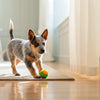Understanding the German Pinscher Temperament: A Guide for Dog Lovers and Owners
- Houndsy
Table of Contents
- Introduction
- The Historical Roots Influencing German Pinscher Temperament
- Core Characteristics of German Pinscher Temperament
- Socialization and Training: Shaping Temperament for Modern Life
- Living with a German Pinscher: Making the Most of Their Temperament
- Reflecting on the German Pinscher Temperament
- FAQ: German Pinscher Temperament
Introduction
Have you ever wondered what it takes to share your life with a dog that blends intelligence, energy, loyalty, and a touch of assertiveness all in one? Consider this: dogs with the right temperament can transform not merely your daily routine but the very way you experience companionship. Among such breeds, the German Pinscher stands out as a medium-sized dog whose spirited personality and deep loyalty make it a unique family member. But what exactly defines German Pinscher temperament? How does this breed’s distinctive nature influence training, socialization, and daily care?
In this detailed exploration, we unravel the multifaceted personality traits, behavioral tendencies, and care considerations that shape the German Pinscher’s character. Whether you’re an experienced dog owner or contemplating welcoming this remarkable breed into your home, understanding the German Pinscher temperament will empower you to create a harmonious environment where your pup can thrive.
We’ll cover their origins, intelligence, social needs, and challenges, plus how their temperament interacts with exercise requirements and training styles. Alongside, we’ll share practical insights to enhance how you meet your German Pinscher’s needs — including how innovations like the Houndsy Kibble Dispenser can simplify the feeding ritual, complementing this vibrant breed’s active lifestyle. Ready to dig in? Let’s embark on this journey to better know and nurture the spirited German Pinscher temperament.
The Historical Roots Influencing German Pinscher Temperament
To truly appreciate the German Pinscher’s personality, it helps to look back at their origin story. This breed emerged in Germany between the late 1700s and 1800s, bred primarily as an active working dog tasked with ratting, guarding stables, and keeping farms free of vermin. The breed’s early name, “Rat Pinscher” or “Rat Catcher,” highlights their hunting prowess and fearless nature.
Such a practical, work-oriented origin deeply influences the breed’s temperament today. German Pinschers retain their instinctive drive to seek, chase, and protect their territory. This lineage fosters a dog that is energetic, intelligent, and vigilant—a true working companion in any modern home.
Their appearance—a sleek, muscular build with a glossy coat—and traits like alertness and confidence are a nod to their legacy as nimble farm dogs who needed speed, endurance, and sharp instincts. Recognizing these historical background factors gives us a framework to understand why their temperament skewers toward assertiveness, loyalty, and high energy.
Core Characteristics of German Pinscher Temperament
Intelligence and Independent Thinking
German Pinschers are highly intelligent dogs, notable for quickly grasping new concepts and learning commands. They have sharp problem-solving skills often displayed in dog sports, obedience competitions, and even service roles.
However, alongside intelligence comes a streak of independence that can challenge owners. Unlike some breeds that are driven primarily by pleasing humans, German Pinschers tend to think for themselves. They thrive with an owner who provides firm, consistent leadership and appreciates their confident spirit.
This independence means training requires patience and creativity; regular short sessions with positive reinforcement will keep these bright dogs motivated. Their natural curiosity also makes mental stimulation crucial — an area where interactive feeding tools like the Houndsy Kibble Dispenser can double as puzzle and reward machines, reinforcing good behavior during daily routines.
Loyalty and Protective Instincts
One of the most endearing facets of the German Pinscher temperament is their unwavering loyalty. These dogs form close bonds with their families and are often described as “velcro dogs,” eager to be involved in every aspect of home life.
Their protective nature, a legacy of guarding farmyards, manifests in vigilant watchfulness and alert barking when strangers approach. German Pinschers generally reserve this bark for strangers or unusual activity rather than barking continuously, making them excellent watchdogs without being nuisance barkers.
That said, early and comprehensive socialization is vital to ensure guarding instincts do not escalate into aggressiveness or overprotectiveness. With consistent training and exposure to diverse environments, German Pinschers can distinguish between real threats and harmless visitors.
Energy Levels and Exercise Needs
German Pinschers have a high energy level that demands daily physical and mental exercise. This is not a breed suited for sedentary lifestyles or infrequent walks. Regular activity such as long walks, runs, agility training, or interactive play helps manage their intensity and keep destructive behaviors—like excessive digging or chewing—at bay.
If these exercise needs are unmet, German Pinschers may become bored and restless, which can lead to behaviors that frustrate owners. For apartment dwellers, dedication to multiple daily walks or active play sessions is essential to meet this breed’s spirited disposition.
If you’re contemplating how to fit in exercise alongside feeding your energetic dog, consider the convenience of the Houndsy Kibble Dispenser. Its ergonomic design allows you to integrate feeding with workouts or training by enabling perfect portion control and easy meal prep, saving you bending or messy scooping.
Temperament Around Children and Other Pets
When raised with children, German Pinschers typically do well as family members, especially with older kids (nine years and above) who understand respectful interaction with dogs. Given their assertive and sometimes overbearing nature, supervision around young children is a must to prevent accidental intimidation or rough play.
Regarding other pets, German Pinschers generally get along with dogs familiar to them but can be wary or territorial toward strangers. Their strong prey drive makes them less suitable for homes with small pets such as rodents or rabbits. Early socialization with cats can help reduce tensions, but individual temperament varies.
The German Pinscher’s natural hunting instincts mean smaller animals might trigger chasing behaviors; this is a temperament trait not easily changed. Ensuring secure fencing for outdoor play and using proper training help mitigate risks.
Socialization and Training: Shaping Temperament for Modern Life
The Importance of Early Socialization
Given the German Pinscher’s suspicious stance toward strangers and protectiveness, socialization from an early age is crucial. Puppies should be introduced to a variety of people, environments, noises, and other animals in controlled, positive settings. This helps them grow into confident adults who respond calmly rather than react defensively.
Puppy kindergarten classes or carefully arranged playdates provide excellent venues for this critical developmental phase. Socialization also curbs tendencies toward aggression and excessive barking, both key concerns for potential owners living in community settings.
Training Techniques That Work
Training a German Pinscher demands consistency, positive reinforcement, and patience. These dogs respond best to rewards such as treats, toys, or praise rather than harsh discipline. Their intelligence makes them quick learners, but their independent streak means they will test boundaries if training is inconsistent or if leadership is weak.
Popular methods for German Pinschers often involve clicker training, agility challenges, and scent work, which harness their mental and physical abilities. Short but frequent sessions keep them engaged and prevent boredom, which can otherwise manifest as troublesome behavior.
For an energy-packed breed like the German Pinscher, structured training sessions are also the perfect time to incorporate controlled feeding routines. A tool such as the Houndsy Kibble Dispenser, which provides precise portions at standing height, can be seamlessly integrated, making feeding efficient and part of the daily training ritual.
Living with a German Pinscher: Making the Most of Their Temperament
Daily Care and Exercise Integration
A German Pinscher’s well-being hinges not just on exercise but on a consistent, enriching lifestyle that addresses their mental and social needs. A typical day might include brisk morning walks, play sessions, training drills, and yard time to explore and satisfy their natural hunting instincts.
Using tools that promote convenience and consistency—like the ergonomic and elegantly designed Houndsy Kibble Dispenser—simplifies feeding routines for busy owners. The dispenser’s auto-locking mechanism and large capacity (holding up to 25–30 pounds of kibble) mean you can manage portions without fuss or mess, freeing up time for bonding and activity.
Grooming and Health Considerations
The German Pinscher’s short, smooth coat is relatively low-maintenance, with weekly brushing sufficient to keep their fur glossy and minimize shedding. Grooming sessions are prime opportunities to build trust and reinforce positive interaction, which aligns with their alert and curious temperament.
They are generally healthy but can be prone to conditions like hip dysplasia and eye problems. Regular veterinary checkups and preventive care help maintain their vitality, supporting the active lifestyle their temperament demands.
Adequate nutrition, portion control, and feeding schedules play a vital role in maintaining their weight and health. Accurate portion measurement—easily managed with the Houndsy Kibble Dispenser—assists owners in preventing obesity, a common challenge with highly active breeds if exercise and diet are imbalanced.
Reflecting on the German Pinscher Temperament
The German Pinscher’s temperament is a complex, fascinating mix of intelligence, loyalty, energy, and independence. These qualities demand an owner who values consistency, engagement, and leadership, but reward with deep companionship, alert companionship, and spirited affection.
Does your current dog-feeding routine support the energetic, intelligent lifestyle of a dog like the German Pinscher? Could tools like the Houndsy Kibble Dispenser empower you to thoughtfully integrate proper nutrition with your dog’s routine activities?
By embracing the unique temperament of the German Pinscher and tailoring care accordingly, you unlock the full potential of this breed as both a guardian and a joyful family member.
FAQ: German Pinscher Temperament
Q: Are German Pinschers good family dogs?
A: Yes, they are affectionate and loyal companions but are best suited for families with older children who understand how to interact respectfully with dogs. Early socialization is key for harmonious family life.
Q: How much exercise does a German Pinscher need?
A: German Pinschers require at least an hour of vigorous exercise daily, including walks, play, and mentally stimulating activities to manage their high energy and prevent boredom.
Q: Can German Pinschers live in apartments?
A: They can adapt to apartment living if their exercise needs are met consistently. However, they thrive best in homes with secure yards where they can run and explore.
Q: What training methods are effective with German Pinschers?
A: Positive reinforcement, consistency, short training sessions, and mental challenges work best. They are intelligent but independent, so patient leadership is essential.
Q: How does the German Pinscher’s temperament affect feeding?
A: Their lively nature benefits from structured feeding routines with perfect portion control. Using reliable tools like the Houndsy Kibble Dispenser can help maintain nutrition while fitting into an active lifestyle.
Q: Are German Pinschers good with other pets?
A: They may be wary or chase small pets due to high prey drive. Proper early socialization can improve tolerance toward other dogs and cats but they are not recommended for homes with small rodents or similar pets.
Bringing a German Pinscher into your life is a commitment to embracing a spirited, intelligent, and devoted companion. With patience, structure, and the right support tools—like our thoughtfully designed Houndsy Kibble Dispenser—you can create a joyful and fulfilling partnership that celebrates every facet of this remarkable breed’s temperament. Why not begin that journey today?













